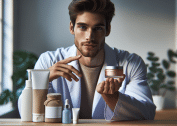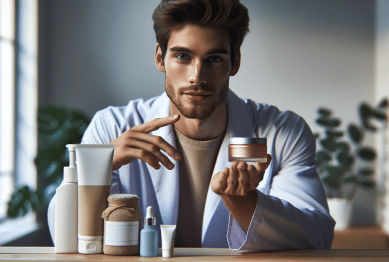Caring for your skin barrier goes beyond moisturizers and trendy serums. Discover why barrier repair is essential for smooth, radiant skin, how ingredients like ceramides and peptides work, and practical strategies to prevent damage. This guide will explain each step, highlight common pitfalls, and offer insights based on science-backed skin health.
Understanding the Skin Barrier and Why It Matters
The skin barrier consists of a complex layer of lipids, cells, and proteins that protects the body from external aggressors. Everyday exposure to pollution, sun, and harsh cleansers can weaken this vital shield, leading to dryness, redness, and even increased sensitivity. It’s not just sensitive individuals who should care about their barrier function—everyone can benefit from learning how this layer helps maintain hydration and resilience. Healthy skin starts at the surface, but protection runs much deeper. Understanding the composition of the skin’s outermost layer, also called the stratum corneum, is fundamental to realizing its impact on overall skin appearance and comfort. A compromised barrier lets irritants, allergens, and bacteria penetrate more easily, causing a cascade of issues that can be hard to reverse. That’s why proactive barrier repair is now a cornerstone of modern skin care.
Maintaining a robust skin barrier isn’t simply about avoiding harsh products, though that is important. It means supporting the skin’s natural repair mechanisms with beneficial nutrients and a gentle routine. Ceramides, cholesterol, and fatty acids form much of the ‘mortar’ that keeps skin cells locked together, preventing moisture from escaping. If these elements are depleted, water loss increases, leading to tightness and flakiness. Environmental damage such as ultraviolet light and air pollution can disrupt this balance further, causing inflammation and accelerating visible aging. The reality is that when your barrier is strong, skin behaves better in nearly every way—from smoothness and clarity to resistance against future triggers. Barrier science is still evolving, but recent research continues to confirm just how essential this protective layer is.
Skin barrier impairment is surprisingly common, especially in individuals experimenting with exfoliating acids, retinoids, or frequent face washing. Symptoms can range from itching and redness to dullness and inflammation. Recognizing these warning signs is the first step in developing a healthier regimen. Simple skincare, focused on barrier repair, can help restore balance. Avoiding unnecessary products or fragrances and instead reaching for formulas rich in ceramides, niacinamide, and soothing botanicals might yield visible improvements faster than expected (Source: https://www.aad.org/public/everyday-care/skin-care-basics/dry/skin-barrier).
How Ingredients Like Ceramides and Peptides Support Barrier Repair
Many popular skin care ingredients go beyond surface hydration and actively help rebuild the barrier. Ceramides, naturally found in skin, are particularly powerful. These lipid molecules work like glue, sealing spaces between skin cells and keeping both moisture and irritants in check. Using a moisturizer containing ceramides can strengthen the barrier’s protective shield, resulting in less dryness and sensitivity over time. Clinical studies suggest that topical ceramide application restores lipid balance faster than the body’s repair process alone. People see softer, less reactive skin, especially when paired with fatty acids and cholesterol for a “skin-identical” effect. This combination can be particularly supportive during times of environmental stress or after intensive exfoliation (Source: https://www.ncbi.nlm.nih.gov/pmc/articles/PMC5849435/).
Peptides are another ingredient class that work wonders for skin resilience. These tiny protein fragments serve as messengers, guiding skin repair and renewal. Some peptides encourage natural collagen production, indirectly strengthening the barrier over time. Others are engineered to mimic the effects of naturally occurring skin proteins, helping with hydration and elasticity. While the science is still emerging, more dermatologists are advocating for peptide-enriched creams in sensitive or damaged skin routines. Combining ceramides, peptides, and gentle humectants like glycerin or hyaluronic acid helps reinforce the skin’s structure, soothe irritation, and trap water close to the surface. This synergy makes formulas with these components a solid choice for anyone looking to restore glow without increasing inflammation.
Choosing the right blend is important, as every skin type responds differently. Sensitive complexions may prefer fragrance-free creams with a balance of barrier lipids and calming plant extracts, such as colloidal oatmeal or panthenol. Others may benefit from formulas that combine peptide complexes with light antioxidants for a multitasking boost. The key is patience—consistent use helps the barrier grow stronger in a way that is both sustainable and visible (Source: https://www.health.harvard.edu/blog/skin-barrier-basics-what-it-is-and-how-to-protect-it-202111232655).
Common Skin Barrier Mistakes and How to Avoid Them
It’s easy to make missteps on the path to radiant, healthy skin—especially when bombarded by trending beauty advice. Over-exfoliation tops the list of common skin barrier mistakes. Many people layer acids, scrubs, or cleansing devices, not realizing it disrupts the fragile lipid layer. Visible results, like smoothness or brightness, can be short-lived if the barrier becomes compromised. To protect skin long-term, experts recommend exfoliating only as needed and always following with an emollient moisturizer. Even “gentle” exfoliants can harm some people, so trial and observation are key. Moderation—not more products—is the surest path to resilient skin (Source: https://www.aad.org/public/everyday-care/skin-care-secrets/dry/restore-skin-barrier).
Hot water and frequent cleansing can also strip essential lipids, significantly weakening the skin’s barrier. Many individuals wash their faces multiple times a day or rely on foaming cleansers, causing tightness and irritation. Dermatologists advise limiting washes to twice daily with lukewarm water. Opting for cream or oil-based cleansers, which remove dirt without dissolving natural oils, is a smart swap for those battling ongoing dryness or redness. It’s wise to check ingredient lists and avoid alcohol-heavy or highly fragranced products, as they can further disrupt the barrier. Gentle routines pay off in stronger, more predictable skin responses over time.
Another frequent mistake is reacting to every blemish or flare-up with multiple new products. Chasing immediate improvement often leads to a cycle of sensitivity, as the skin never has a chance to recalibrate. Skin needs predictability to regain balance. Experts recommend introducing only one new product at a time, monitoring for reactions, and giving routines at least several weeks before assessing results. This approach is gentle and proven, reducing both stress and unnecessary expense. Ultimately, healthy skin stems from respect for its limits and understanding when to step back and let natural repair occur (Source: https://www.ncbi.nlm.nih.gov/pmc/articles/PMC7573654/).
Prevention and Daily Practices for Stronger Skin
Lifestyle choices play a bigger role in skin barrier health than many realize. Regular sunscreen use prevents ultraviolet radiation from breaking down essential proteins and fats at the skin’s surface. Even incidental sun exposure, such as through windows or on cloudy days, accumulates damage over time. Select a broad-spectrum sunscreen, ideally with added moisturizers and antioxidants, for daily defense. Consistency helps—most UV-related skin barrier impairment is preventable with basic routine adherence (Source: https://www.skincancer.org/skin-cancer-prevention/sun-protection/sunscreen/).
Diet and sleep quality also influence the skin’s regenerative capacity. Omega-3 fatty acids, found in fish and plant oils, have been shown to support both systemic and skin lipid synthesis. Hydration—via water and water-rich foods—assists cellular repair, keeping everything supple and resilient. Sleep acts as a natural barrier booster, giving the epidermis a chance to heal from daily micro-damage. Those who get consistent rest tend to report fewer flare-ups and longer-lasting glow. Making time for restorative practices, whether it’s a relaxing nighttime routine or conscious meal planning, really can translate into visible skin improvement. It’s not just what’s applied externally; internal wellness counts too.
Daily habits matter. Avoiding smoke-filled environments and managing stress are both linked with healthier skin barrier function. Simple adjustments like switching to a humidifier in dry months, taking cool (rather than hot) showers, or using protective gloves during household chores all add up over time. Individualized routines are especially important for those with pre-existing sensitivities or chronic skin conditions such as eczema or rosacea. Consulting credible guides and updating habits as needed creates an environment for continual skin improvement (Source: https://www.dermcoll.edu.au/atoz/skin-barrier-function/).
Supporting Sensitive and Aging Skin Through Barrier Repair
Sensitive skin and aging skin benefit immensely from barrier-supportive routines. As we get older, the skin’s lipid and protein production slows, making the outer layer more prone to dryness and damage. Sensitive skin can react more intensely to subtle imbalances or irritants. Products with hyaluronic acid, ceramides, and niacinamide often prove nurturing, as they boost both moisture and repair mechanisms. These ingredients, especially when combined with antioxidants like vitamin E, make a noticeable difference in complexion comfort and plumpness. Dermatological research confirms that mature skin needs special support to retain smoothness and reduce the effects of stress and time (Source: https://www.ncbi.nlm.nih.gov/pmc/articles/PMC3583886/).
Barrier repair is also vital for individuals prone to eczema, rosacea, or dermatitis. These conditions are often characterized by impaired microbial equilibrium and decreased natural oils. Routine application of barrier ointments or emollient creams can decrease discomfort, limit flare-ups, and reduce reliance on prescription treatments. Many experts recommend minimal, non-irritating routines with an emphasis on moisture and environmental shielding. Support doesn’t stop at products, though—emotional stress management and supportive habits, such as wearing sun-protective clothing, create a feedback loop for better skin resilience. Investing attention in these supportive practices pays off in comfort and confidence.
Skincare trends will change, but the fundamental goal of barrier repair remains the same: healthy, adaptable skin that withstands challenges with ease. Adapting your habits to your skin’s evolving needs, seeking guidance from credible sources, and focusing on prevention over correction leads to the best outcomes. Ultimately, skin barrier repair is a process, not a single product or step. When approached with curiosity and patience, it’s possible to achieve lasting results that go much deeper than the surface.
References
1. American Academy of Dermatology. (2023). How to repair and care for your skin barrier. Retrieved from https://www.aad.org/public/everyday-care/skin-care-basics/dry/skin-barrier
2. Tong, P.L. et al. (2015). The Skin Barrier Function: How to Evaluate and Restore. Retrieved from https://www.ncbi.nlm.nih.gov/pmc/articles/PMC5849435/
3. Harvard Health Publishing. (2021). Skin barrier basics: What it is and how to protect it. Retrieved from https://www.health.harvard.edu/blog/skin-barrier-basics-what-it-is-and-how-to-protect-it-202111232655
4. American Academy of Dermatology. (2022). How to restore your skin barrier. Retrieved from https://www.aad.org/public/everyday-care/skin-care-secrets/dry/restore-skin-barrier
5. Skin Cancer Foundation. (2024). Sunscreen. Retrieved from https://www.skincancer.org/skin-cancer-prevention/sun-protection/sunscreen/
6. Australasian College of Dermatologists. (2023). Skin Barrier Function. Retrieved from https://www.dermcoll.edu.au/atoz/skin-barrier-function/









